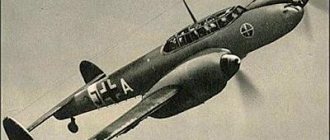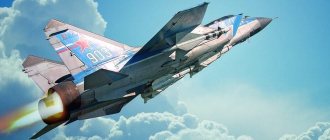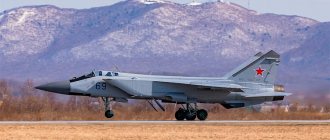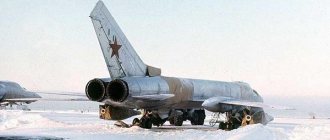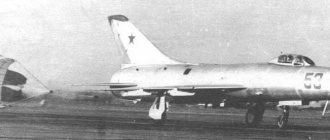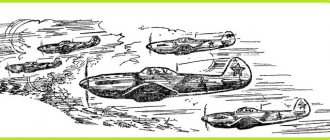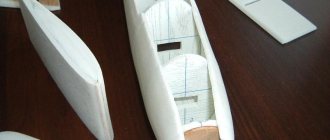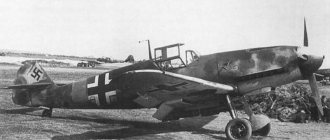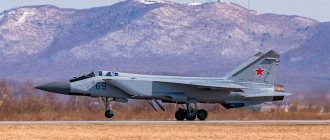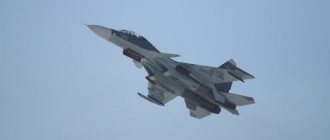Photo of the Luftwaffe fighter Messerschmitt Me-163 Komet
The Messerschmitt Me-163 “Komet” is a fighter that combines several innovations at once - a “tailless” aerodynamic design and a liquid-propellant rocket engine (LPRE) as a power plant. The design of the airframe was based on the developments of A. Lippisch. Since 1935, the development of the tailless concept has been carried out at the DFS Research Institute. At the same time, the development of liquid rocket engines was carried out under the leadership of G. Walter. In January 1939, Lippisch's group switched to , where they continued to refine tailless gliders with an eye to installing a liquid-propellant rocket engine. In August 1940, tests began on the DFS 194 aircraft with the Walther HWK RI liquid-propellant rocket engine with a thrust of 400 kgf. Their successful results accelerated the development of an improved version of the machine, designated Me 163A. At that time it was considered as a research project. The aircraft was equipped with a HWK R I-203b rocket engine and did not have a normal landing gear: takeoff was carried out using a drop-down wheeled trolley, and landing was carried out on a ventral ski. The engine operating time was only 4 minutes.
10 copies of the Me 163A were built and used for testing. The first flight with a liquid-propellant rocket engine took place on August 18, 1941. Already in the first flights, the aircraft reached a horizontal speed of 800 km/h, and on October 2 it exceeded the 1000 km/h mark (however, in the latter case, the Me 163A took off in tow, and only after climbing altitude the rocket engine was launched).
The excellent speed characteristics of the Me 163A aroused the interest of the Reich Ministry of Aviation, which demanded that the aircraft be converted into an interceptor fighter, increasing the engine operating time to 12 minutes. To do this, it was necessary to redesign the fuselage, increasing its volume, which was used to accommodate tanks with oxidizer (hydrogen peroxide). The fuel supply (a mixture of hydrazine hydrate and methanol) was located in the wing. The first order, issued on December 1, 1942, was for 70 aircraft, which were interpreted as pre-production. Production was carried out by Messerschmitt in Regensburg and Böblingen. The total production volume is estimated at 400-450 copies.
Flight characteristics of Messerschmitt Me 163B-1 aircraft
- Engine: HWK 109-509A-1
- maximum thrust, kgf: 1600
- Wingspan, m: 9.33
- Aircraft length, m: 5.98
- Aircraft height, m: 2.75
- Wing area, sq. m.: 18.5
- Weight, kg:
- empty plane: 1905
- takeoff: 3950
- maximum takeoff: 4310
- Maximum speed, km/h:
- near ground: 825
- at altitude: 955
- Rate of climb, m/s: 80
- Flight range, km: 200
- Practical ceiling, m.: 12000
FIRST VICTORIES AND FIRST LOSSES
Among aviation strategists there were two concepts for using the Me 163B. The author of one of them was V. Spete, who advocated basing squadrons of missile fighters on airfields located from north to south, vertically, along the main flight routes of Anglo-American bombers. The German airfield infrastructure ensured such a location of interceptor bases, as well as a horizontal one, from west to east. Späte’s “vertical” option made it possible to attack bombers over a significant part of their route over Germany and seemed quite reasonable, given the short flight duration and range of the Me 163B. However, according to Luftwaffe day fighter commander Gordon Gollob, a single use of the Me 163B was a “stretched-fingered strike” that was not capable of “knocking out” the enemy. Unlike Shpete, the general proposed deploying a Komet group of three or four squadrons at one airfield and attacking the enemy en masse to cause maximum damage.
The main sign by which the crews of Allied aircraft detected the launch of rocket planes was the light plume of exhaust from liquid-propellant rocket engines
Considering that Späte’s concept did not justify itself, and his influence on the tactics of using the Me 163 after leaving for the Eastern Front decreased, the Gollob doctrine began to prevail. In fulfillment of his plan, in July 1944, the squadron 1./JG 400 was relocated to Brandis, near Leipzig, and in August - 2./JG 400. The latter, under the command of Hauptmann Otto Bechner, had previously provided air defense for the Venlo airfield, from which He 111N aircraft carrying V1 cruise missiles carried out raids on Great Britain. Both squadrons were included in group I/JG 400, whose commander was R. Oleinik, who transferred his squadron to Hauptmann W. Fulda. The first squadron was armed with 16 Comets, the serviceability of which was approximately 50%. Of the six Me 163s of the second unit, only two could participate in combat operations.
Thus, even taking into account the serviceable aircraft of the 3./JG 400 squadron, which was part of Oleinik’s group, under the command of Hauptmann Falderbaum, only about a dozen “Comets” could be used in battle. It would be naive to expect great results from so many machines, even piloted by the most experienced pilots. Nevertheless, the change in tactics brought first results. So, on July 28, 1944, at the Brandys airfield, seven pilots of I/JG 400 took up combat duty, on all aircraft that were operational that day. Five of them flew out to intercept an armada of American B-17 Flying Fortresses, accompanied by a large number of P-38 Lightning and P-51 Mustang fighters. There is talk of a thousand planes in total! Having gained an altitude of 10,000 meters, the Comets attacked the formation of bombers from the rear hemisphere, fired at them to no avail, and planned to their airfield.
The victory of the Me 163 over the main enemy - the B-17 bomber, as imagined by the artist
American fighter pilots detected the launch of rocket planes using liquid rocket engine plumes, but were unable to cause harm to the high-speed aircraft. This was the first group air battle using airborne weapons, in which Lieutenant G. Bott, sergeants Z. Schubert, H. Rill, R. Glogner and others took part. The next day, six Me 163s took part in repelling a raid on a large gas storage facility in the Leuna area . The Americans stated that one Me 163 was shot down by a P-38 fighter, but according to documents 1./JG 400 had no losses that day. The first victory was won on August 16. On this day, American bombers flew to bomb Dresden, Halle, Magdeburg and Dessau. Five Komets took part in repelling the raid. Lieutenant Reil was the first to win, shooting down a B-17, but he himself came under fire from a P-51 and died.
This was the first combat loss among the jet fighters. Another “Comet” was “taken down” by the rear gunner of the B-17. Sergeant Major Strazhnitsky was lucky; he escaped by parachute.
The Comets' worst enemy is the B-17 rear gunner
In the next battle on August 24, the pilots of I/JG 400 shot down four B-17s, two of which were chalked up by Sergeant Major Schubert, while the Germans lost one Me 163. Thus, the change in tactics began to produce results, but technical problems made themselves felt .
Main modifications of the Me-163 Komet:
Me 163 V - instead of a wooden landing ski, a metal one is used, in addition, a tail wheel is installed. Armament - 2 20-mm MG 151/20 cannons with 100 rounds of ammunition (on the first 46 aircraft, designated Me 163В-0) or 2 30-mm MK 108 cannons (60 rounds each; aircraft with such weapons were designated Me 163В- 1). The power plant on the first copies was the Walter HWK 109-509A-0 liquid rocket engine with thrust adjustment within the range of 300-1500 kgf. Then HWK 109-509A-1 (100-1600 kgf) was used. Fuel consumption in practice turned out to be higher than calculated, and the operating time of the liquid-propellant rocket engine did not exceed 8 minutes.
Me 163 S is a two-seat, non-motorized training version, intended for landing training. Several copies were built.
The improved modifications Me163C and Me 163D did not have time to enter mass production.
Messerschmitt Me.163 - missile fighter-interceptor
The history of the German Me.163 Komet missile fighter-interceptor clearly shows what the pursuit of the magic of numbers can lead to. An attempt to design a combat aircraft based on an experimental model with an unconventional design ended in complete failure. The pilots of the combat units had to make sure of this. In fact, the only reason why this aircraft could ultimately become a combat vehicle was its speed. For the first time in the history of aviation, this aircraft was able to overcome the speed mark of 1000 km/h. Germany was one of the few countries in which, since the 30s of the last century, work has been carried out to create jet-powered aircraft. One of the types of jet engines was the liquid rocket engine. It was he who was used on the Comet fighter. The Me.163 Komet aircraft clearly demonstrated the ability of German designers and engineers to bring even an unpromising and unfinished concept to working condition. The main problem was that liquid rocket engines had a very high fuel consumption, which in turn led to a significant reduction in flight time, which was only a few minutes. In addition, the liquid-propellant rocket engine had another fatal feature - quite often, when performing a hard landing, it simply exploded.
Work on the design of the Me.163 was in some way a response to the Allied bombing. The aircraft created by German designers was unique; it had an unconventional “tailless” design, took off from a special cart, and landed on a ski that extended from under the fuselage of the aircraft. This aircraft, despite its unsuccessful combat use, left a very bright mark on the history of aviation technology. It was the only tailless aircraft that was equipped with a rocket engine and was able to take part in combat operations.
In addition, this aircraft had a narrow specialization - it was a daytime interceptor, which was supposed to be used to combat Allied bomber aircraft. The interceptor fighter developed a record speed for its time and had a record rate of climb. At the same time, the designation Me.163 was assigned to this aircraft undeservedly. The creative contribution of Willy Messerschmitt and his company to the creation of this machine was extremely small. The chief designer of the aircraft was Professor Alexander Lippisch. Also, 2 major officials from the Reich Ministry of Aviation had a hand in the birth of this unusual machine. Namely, the head of the testing department, Dr. A. Boimker, who was a staunch supporter of the introduction of rocket engines in aviation, as well as his deputy, Dr. Lorenz, who came up with the idea of installing a rocket engine on a tailless aircraft. Thus, it was intended to remove all important components of the aircraft as far as possible from the hot torch.
Description of design
The fuselage of the fighter had a spindle-shaped shape, to which the ventral beam and the upper garrot gave an oval cross-section. During operation of the aircraft, its fuselage could be undocked into 2 parts, which allowed access to the power plant. In the forward part of the fuselage there was a compartment for equipment, an oxidizer tank, a cockpit and a landing ski. The basis for the strength structure of the forward fuselage was a strong ventral beam and 4 power frames. The nose part was made of duralumin. The nose cone was made of armor steel, the thickness of which was 15 mm. Although the cone weighed more than a flat armor plate, it provided better protection for the pilot, since large impact angles increased the likelihood of shells and bullets ricocheting. The main equipment units of the vehicle were located under the nose cone.
Following the nose was the cockpit, which was surprisingly spacious for such a small aircraft. The cabin was covered with a special lantern, which folded down to the right side. An interesting fact is that the lantern had no bindings, while ensuring strength even when flying at the highest speeds. Later in the 1960s, the creation of such canopies without bindings and without optical distortion was presented as the latest achievement in the field of aviation technology. During the work on fine-tuning the aircraft, a small window was created in the canopy, which served to ventilate the cabin from oxidizer vapors, which caused the pilots to water.
In addition to the armored cone, the pilot's front protection was also provided by 90 mm armored glass, which was installed above the instrument panel. On both sides of the cabin, along the sides of the aircraft, there were protected tanks that were filled with oxidizer (with a capacity of 60 liters). This decision was considered bad, but it was a necessary measure. This placement was supposed to provide centering for the aircraft while it was running out of fuel. There was a known case when, during a hard landing, the oxidizer that leaked from a cracked tank simply dissolved the pilot. 3 armor plates were installed on the rear wall of the cabin, which covered the pilot’s head, shoulders and back (13, 8 and 13 mm thick, respectively). The pilot's seat was attached to the same wall using special shock absorbers.
The cabin of the interceptor fighter was not pressurized, so the pilots often suffered from the cold, and also had to be in good health and in good physical shape, since the rapid climb to altitude was accompanied by large pressure differences. To ensure the pilot's vital functions during flights at high altitude, the aircraft was equipped with an oxygen device, which was mounted to the right of the pilot. The oxygen cylinder and charging fitting were installed on the right above the wing fairing.
Behind the cockpit was the main oxidizer tank (capacity 1040 liters). In order to facilitate access to it, as well as to the fuel system units and pipelines, this compartment was covered from above with a special removable garrot. The filler necks of the tank were located on the top. Below, under the front part of the fuselage, there was a powerful beam to which the landing ski was attached.
The rear fuselage of the aircraft was located in an area exposed to high temperatures, so it was made of steel. A wooden keel with a rudder, which had a duralumin frame and fabric covering, was mounted on the top of the tail compartment. The steering wheel had weight balancing and developed aerodynamic compensation. At the bottom of the tail section there was an additional keel, to which a retractable tail wheel was attached. This compartment also had ventilation holes that served to remove fuel vapor and cool the power plant.
The fighter-interceptor's take-off and landing device included a take-off drop cart, a tail wheel and a steel landing ski. Initially, they tried to make the ski from wood or duralumin, but ultimately steel was chosen as the material for its manufacture. The dump cart had wheels measuring 700 by 175 mm and was attached to the ski using a special lock. While cleaning the ski, the lock opened and the cart was thrown down. The ski and tail wheel were retracted and released using a pneumohydraulic system.
The main highlight of the car was its power plant. The aircraft had three tanks with oxidizer (1160 liters) and four tanks with fuel in the wing (volume 500 liters). Thus, the total filling volume was 1660 liters (about 2026 kg of weight). At the request of the pilots, the aircraft was equipped with a valve that allowed the oxidizer to be drained during the flight. This was used to prevent an explosion during a hard landing.
The aircraft was equipped with an HWK 109-509A-2 engine, which had 2 combustion chambers: starting and sustaining. The launch chamber, which has a maximum thrust of 1700 kgf and the possibility of its stepwise reduction to 200 kgf, was used during takeoff and climb. A sustainer chamber with a constant thrust of 300 kgf was used in cruising flight mode. A mixture of 80 percent hydrogen peroxide and a liquid catalyst (a mixture of methanol, hydrazine hydrate and water or a solution of potassium permanganate) was supplied to the engine. In the combustion chamber of the engine, hydrogen peroxide decomposed to form a large amount of superheated gaseous mixture, which provided powerful jet thrust.
Combat use
The combat use of Me.163 fighter-interceptors can be called unsatisfactory. Before the end of hostilities, these fighters shot down 16 (according to other sources, 10) enemy aircraft. At the same time, their own losses were estimated at 14 vehicles. Considering that the number of all manufactured Me.163s exceeded 3 hundred, the result of their combat use is more than modest.
The main reasons for such low efficiency were: too short duration of operation of the liquid-propellant rocket engine (about 8 minutes). Which, in turn, greatly limited the range of use of the aircraft, and also required very high-quality targeting from ground services, which at the end of the war Germany could no longer provide. The aircraft's armament set was also considered incorrect. The automatic cannons installed on it had time to fire only a few shells at the target, after which the enemy was out of range of the fighter's aimed fire.
Separately, the excessive toxicity and fire hazard of the fuel used was noted, which led to a large number of disasters and accidents in which more equipment and people were lost than in battles with Allied aircraft. The low operational reliability of the engine and the aircraft as a whole, as well as the low level of training of fighter pilots, also played a role.
Performance characteristics of the Messerschmitt Me.163
Dimensions: wingspan – 9.3 m, length – 5.7 m, height – 2.75 m. Wing area – 18.5 sq. m. Aircraft weight, kg - empty - 1,900 - normal take-off - 3,910 - maximum take-off - 4,300 Engine type - one Walter HWK 509 diesel turbojet engine, thrust 1,700 kgf. The maximum speed at the ground is 825 km/h, at altitude – 955 km/h. Practical range – 200 km (flight duration 8 minutes)
Service ceiling – 12,100 m. Crew – 1 person. Cannon armament: 2x20 mm MG 151 cannons (100 rounds per barrel) or 2x30 mm MK-108 cannons (60 shells per barrel).
Sources used: www.airwar.ru/enc/fww2/me163.html www.airpages.ru/lw/me163.shtml www.wunderwaffe.narod.ru/Magazine/AirWar/38/01.htm www.aviacija.dljavseh. ru/Samolety/Messerschmitt_Me_163_Komet.html
